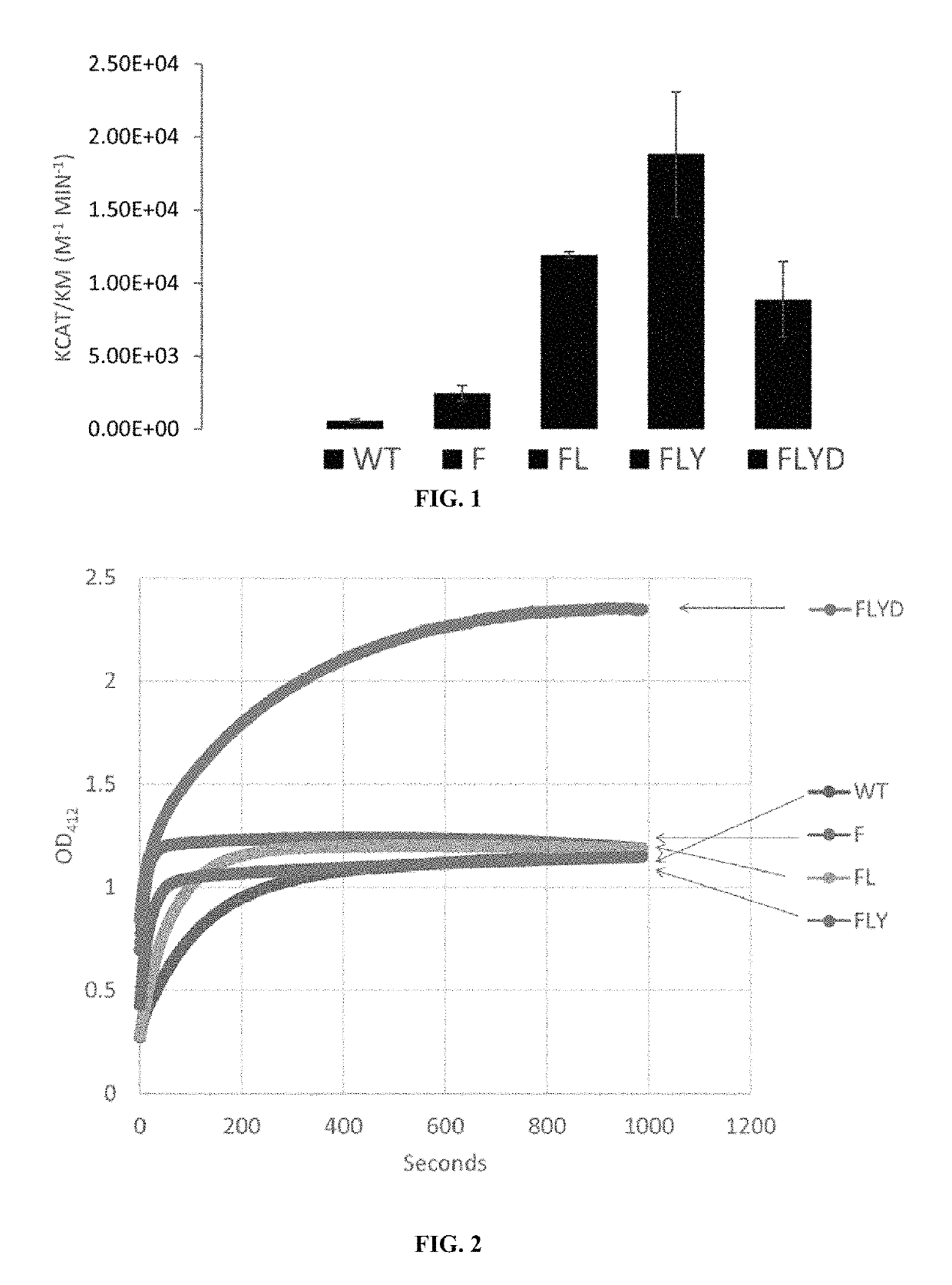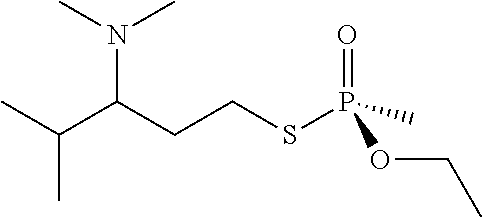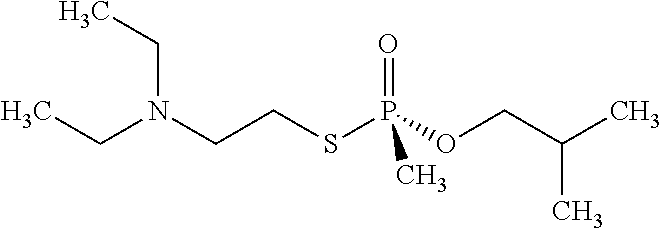Engineered organophosphorus acid anhydrolases and methods of use thereof
an anhydrolase and organophosphorus acid technology, applied in the field of genetically engineered organophosphorus acid anhydrolase polypeptides, can solve the problem of not having any activity agains
- Summary
- Abstract
- Description
- Claims
- Application Information
AI Technical Summary
Benefits of technology
Problems solved by technology
Method used
Image
Examples
example 1
Engineered OPAA have Increased Enzymatic Activity for VR Chemical Agent
Materials and Methods
[0207]Materials
[0208]Chemical agent substrates were obtained from Edgewood Chemical Biological Center stocks and were Chemical Agent Standard Analytical Reference Materials, typically of greater than 95% purity. Chemicals, biochemicals, buffers and solvents were purchased from Sigma-Aldrich Chemical Co. (St. Louis, Mo.), Fisher Scientific, Inc. (Pittsburgh, Pa.), or Acros Organic (Morris Plains, N.J.), unless otherwise indicated. 5,5′-dithio-bis(2-nitrobenzoic acid) (DTNB, CAS-69-78-3) was purchased from Sigma, item number D8130, lot number 54H0479. Ethyl acetate (CAS 141-78-6) was purchased from Aldrich, item number 11,0002-7, lot number 143110BZ. Bis-tris-propane (CAS 66431-96-5) was purchased from Sigma, item number B6755-1KG, lot number SLBD7878V. MnCl2 (CAS 13446-34-9) was purchased from Sigma, item number M-3634-100G, lot number 111K0151.
[0209]OPAA Expression Vector and Site-directed Mu...
example 2
Crystallization of Engineered OPAAs
Materials and Methods
[0222]X-Ray Structure of Engineered OPAAs
[0223]X-ray data sets were collected using crystals mounted onto polymer loops (Mitegen) and flash-cooled in liquid nitrogen. All crystals were passed through a cryo of 20% isopropanol, 15% PEG 4,000, and 5% Glycerol before being mounted under a stream of dry N2 at 100 K. Collections for all data sets used an X-ray beam wavelength of 1 Å. For the OPAA Y212F, the 2.1 Å data set was collected using the SER-CAT beam line 22-BM and a MAR 225 detector. For OPAA Y212F in complex with mipafox and the OPAA FLY, the 2.4 Å data sets were collected using the SER-CAT beam line 22-ID and a MAR300hs detector.
[0224]X-ray images were indexed, processed, integrated, and scaled using HKL2000 (Otwinowski, et al., Macromolecular Crystallography, Part A, Academic Press, 276 (1997)). An initial phase solution for OPAA Y212F was elucidated using wild-type OPAA [Protein Data Bank (PDB): 3L24] as a starting mode...
example 3
FLYD Variants have Broader Substrate Specificity
[0234]An enzyme's enantiomeric preference, where it exists, can be determined by degrading half the substrate (essentially, the enantiomer on which the activity is greatest) and measuring the direction in which the remaining substrate (i.e., the least preferred enantiomer) rotates plane polarized light in a polarimeter. Following that approach, the PTE enzyme was used to degrade a solution of 1 gram of VR in 1 L of buffer. The reaction was sampled periodically and followed spectrophotometrically and was extracted with ethyl acetate when just over half the starting VR had been degraded. The concentrated ethyl acetate extract of that solution was determined by polarimetry to be comprised predominantly of the P(−) enantiomer, indicating an enzymatic preference for the P(+) enantiomer.
[0235]Using knowledge of the enantiomeric preference of one enzyme on one substrate, it is possible to mix that reference enzyme with one of unknown enantiom...
PUM
| Property | Measurement | Unit |
|---|---|---|
| concentrations | aaaaa | aaaaa |
| concentrations | aaaaa | aaaaa |
| concentrations | aaaaa | aaaaa |
Abstract
Description
Claims
Application Information
 Login to View More
Login to View More - R&D
- Intellectual Property
- Life Sciences
- Materials
- Tech Scout
- Unparalleled Data Quality
- Higher Quality Content
- 60% Fewer Hallucinations
Browse by: Latest US Patents, China's latest patents, Technical Efficacy Thesaurus, Application Domain, Technology Topic, Popular Technical Reports.
© 2025 PatSnap. All rights reserved.Legal|Privacy policy|Modern Slavery Act Transparency Statement|Sitemap|About US| Contact US: help@patsnap.com



